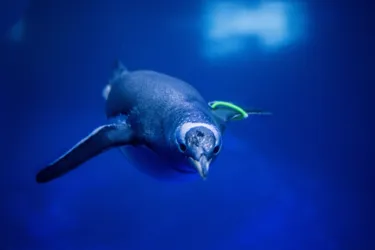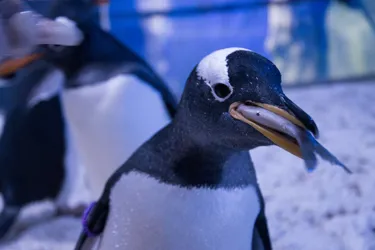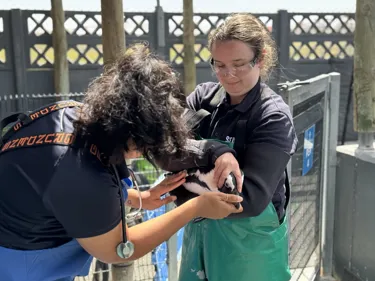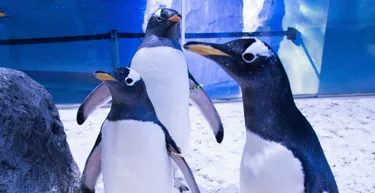Penguin Awareness Day: Celebrating and Protecting Our Feathered Friends
- Wednesday 8th January 2025

January 20th is Penguin Awareness Day—a time to celebrate these remarkable birds and highlight the urgent need to protect them. Penguins are more than just adorable animals; they’re key indicators of ocean health and vital players in marine ecosystems. With 11 out of the 18 penguin species classified as vulnerable or endangered, it’s critical to understand the challenges they face and how we can help ensure their survival.
Penguins: A Story of Evolution
Did you know that penguins have been around for over 30 million years? Their ancestors likely originated from the coasts of New Zealand and Australia. These early flightless birds evolved from species resembling albatrosses, taking to the water where food was abundant. Over time, their wings transformed into powerful flippers, making them expert swimmers and divers. While penguins gave up flight, they became the fastest swimming and deepest diving birds in the world.
Interestingly, penguins have never inhabited the North Pole. Their black-and-white colouring and waddling gait often lead to confusion with puffins or the extinct Great Auk, but these species are unrelated.
A World of Penguins
It is thought there are as many as 17 to 20 different species of penguins, each uniquely adapted to their environments. For example, Emperor Penguins are built to endure the harshest conditions of Antarctica, with a layer of fat and dense feathers for insulation. In contrast, Magellanic Penguins and Banded Penguins thrive on the sunny beaches of South America and Africa, using burrows to protect themselves from the heat. Other species like Gentoo Penguins are known for their incredible swimming speed, while King Penguins and Adelie Penguins are famous for their striking appearances and social behaviours. Most penguins live in the Southern Hemisphere, but none inhabit the North Pole.

The African Penguin: A Species in Crisis
One of the most endangered penguin species is the African Penguin, native to the coasts of South Africa and Namibia. Over the past 50 years, their population has declined by more than 50%, mainly due to human activities such as overfishing, habitat destruction, and oil spills.
To combat this decline, SEA LIFE partners with the Southern African Foundation for the Conservation of Coastal Birds (SANCCOB). This Cape Town-based charity focuses on rescuing, rehabilitating, and releasing ill, injured, or abandoned African Penguins. SANCCOB’s dedicated efforts aim to reverse the population decline and provide these incredible birds with a fighting chance.

Unique Penguin Adaptations
Penguins are fascinating creatures with several unique adaptations:
- Swimming Specialists: Penguins’ streamlined bodies and flippers make them efficient swimmers. Their supraorbital gland near the eyes helps filter salt from seawater, allowing them to stay hydrated in marine environments.
- Catastrophic Molt: Unlike most birds, penguins shed all their feathers at once during their annual molt. This process, called a “catastrophic molt,” leaves them unable to swim or hunt, requiring them to store fat to survive the fasting period.
- Surviving Harsh Environments: Penguins thrive in extreme conditions, but threats like climate change, plastic pollution, and overfishing put their survival at risk.
How You Can Help Penguins in the Wild
Protecting penguins starts with individual actions:
- Eat Sustainable Seafood: Choose responsibly sourced seafood to reduce overfishing—a major threat to penguins’ food supply.
- Dispose of Rubbish Properly: Plastic pollution is a significant danger to marine life. Recycle, reuse, and ensure waste is disposed of responsibly.
- Keep a Safe Distance: If you encounter penguins in the wild, admire them from afar to avoid disturbing their habitats.
- Support Conservation Efforts: Organizations like SANCCOB rely on donations and support to continue their vital work. Consider contributing to penguin conservation initiatives.

Join SEA LIFE in Protecting Penguins
At SEA LIFE, we’re committed to marine conservation and protecting penguins. Through partnerships with organizations like SANCCOB and our on-site educational programs, we strive to make a difference.
This Penguin Awareness Day, let’s celebrate these amazing birds and take action to protect them. Together, we can ensure future generations have the chance to marvel at their charm and resilience.

Get to know the penguins we have at SEA LIFE London Aquarium!
Gentoo Penguin
- Size: Medium-sized, they grow to around 75 to 90 cm tall.
- Weight: Typically weigh between 5 to 8.5 kg (11 to 18 lbs).
- Appearance: Gentoo Penguins are easily recognized by their bright orange beaks and a distinctive white stripe that runs across the top of their heads.
- Habitat: Found on the rocky shores of sub-Antarctic islands, particularly around the Falklands, South Georgia, and the Antarctic Peninsula.
- Diet: Their diet consists mainly of krill and fish, making quick, efficient dives to catch their prey.
- Fun Fact: Gentoos are the fastest swimming penguins, capable of reaching speeds up to 36 km/h (22 mph)! They're also known for being particularly playful and curious around humans.